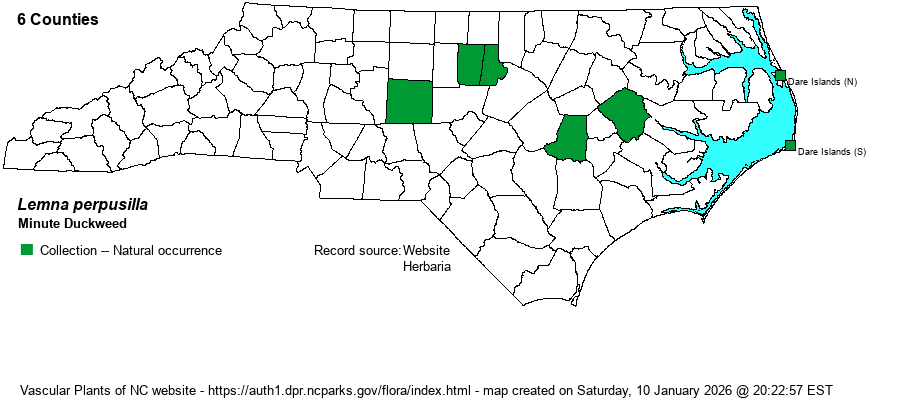| Author | Torrey | |
| Distribution | This species is considered by Weakley (2018) as being limited to the Coastal Plain and Piedmont in NC. Based on the range map below, which is certainly very incomplete, it appears to be limited to the Coastal Plain and the eastern portion of the Piedmont. Note that the BONAP map, and SERNEC, show or list quite a few Coastal Plain counties; however, NCU has very few confirmed records for it, and the website editors believe that most of these Coastal Plain records probably relate to L. obscura or L. aequinoctialis. Website editors have mapped only those specimens that were annotated by experts.
This is a wide-ranging species, from VT and MN south to GA and eastern TX.
| |
| Abundance | Weakley's (2018) map indicates it is "common" in the Coastal Plain but "rare" in the Piedmont. Note that the NHP database does not have Lemna aequinoctialis, L. minor, and L. obscura pulled out of L. perpusilla (broad sense); thus, they simply ranked the broad sense L. perpusilla as S4. In reality, the "new" L. perpusilla (strict sense) may well be less common than that, and so tentatively the website editors have assigned a state rank of S3? until more information is available. Though only six county records show on the map, the fact that Weakley considers it as common in the NC Coastal Plain suggests that it may well be as numerous as an S4 rank. | |
| Habitat | The Habitats for this species and nearly all Lemna species in NC are various pools, ponds, lakes, and other still or very slowly moving waters. |
| Phenology | Flowers and fruits from September to November. | |
| Identification | Lemna species are tiny floating plants with flattened leaf-like stems (fronds) that produce roots under the stem (i.e., under the water surface). These species have just one root per frond. This species has 3-5 nerves on a frond. For further separation characters, see the key in Weakley (2018). | |
| Taxonomic Comments | Though this has long been a good species, in recent decades several other species have been pulled out from it -- such as L. obscura and L. aequinoctialis.
The range maps for this and other duckweeds (Lemna spp.) are likely to be very incomplete, owing to recent changes in nomenclature; not to mention being in a group of plants often overlooked or not often collected by biologists because of their tiny size and aquatic/floating habits. | |
| Other Common Name(s) | Tiny Duckweed | |
| State Rank | S4 [S3?] | |
| Global Rank | G5 | |
| State Status | | |
| US Status | | |
| USACE-agcp | OBL link |
| USACE-emp | OBL link |

